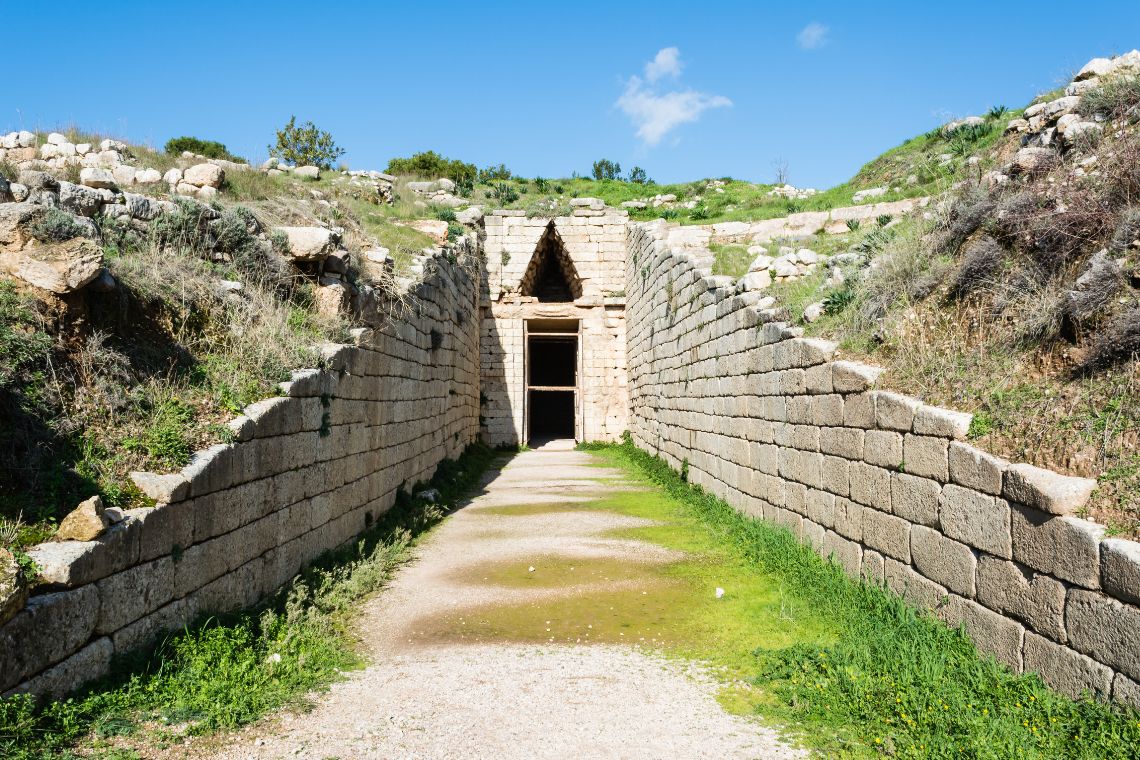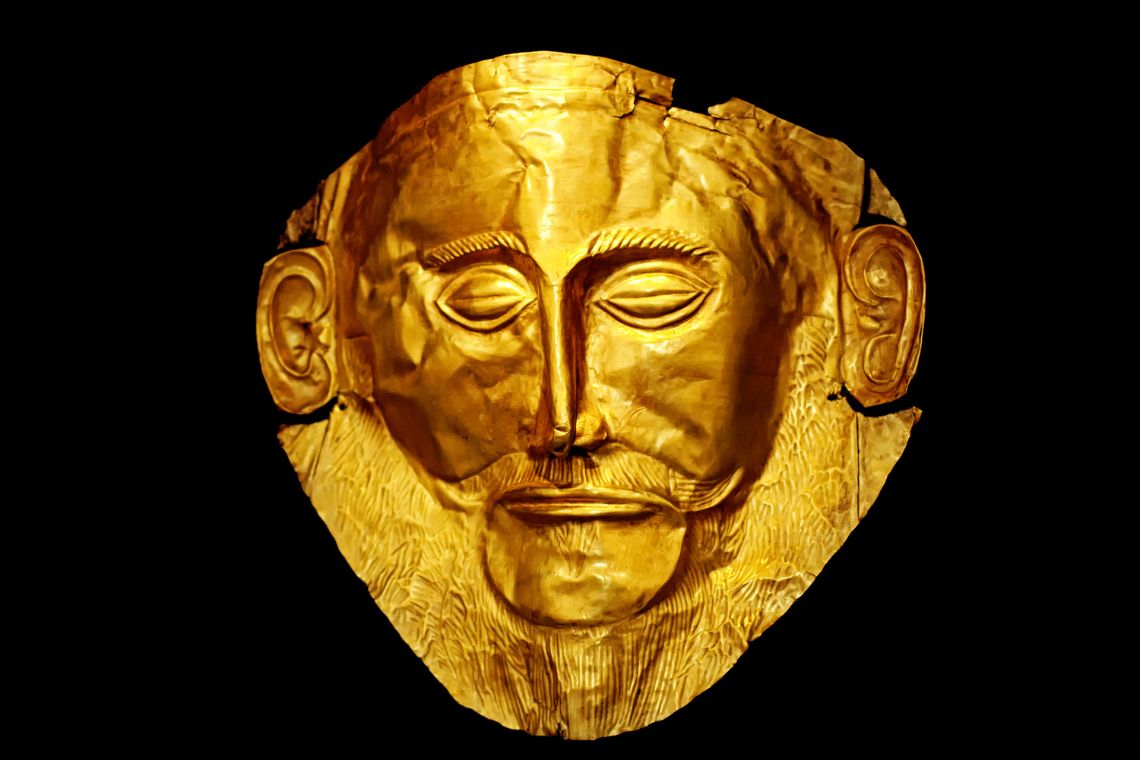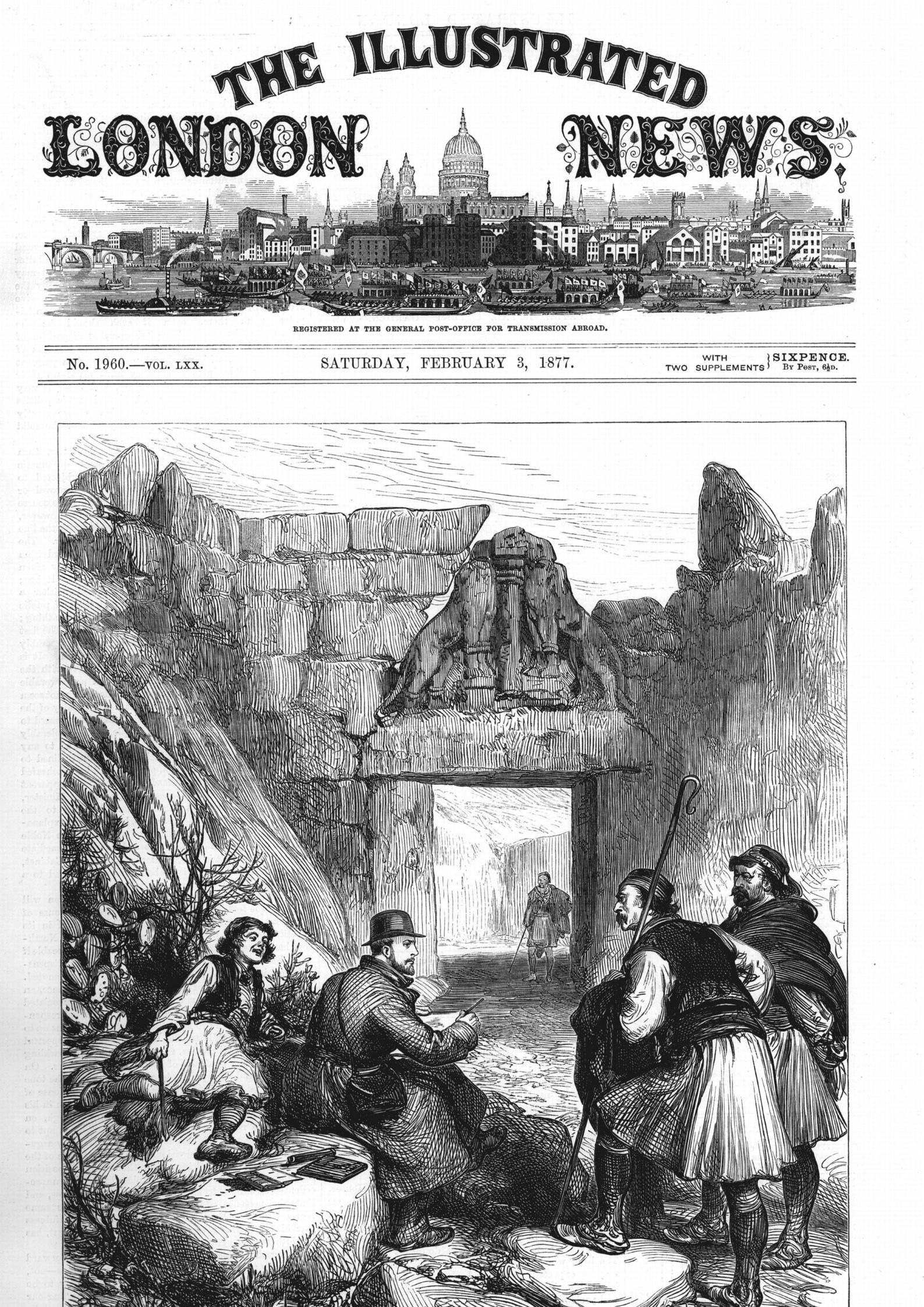7-Day Percy Jackson Mythology Trip
In terms of cultural achievements, the Mycenaean civilization made significant contributions to art, architecture and language. They even developed a writing system called Linear B. Linear B was an early form of the Greek language.
The Mycenaeans were highly skilled in various art forms such as frescoes, pottery and metalwork. Their artifacts included motifs inspired by nature as well as those related to warfare and hunting. These works reflect both their appreciation for beauty and their warrior-oriented society.
In addition, maritime trade and cultural exchange with the neighboring people of the Aegean and the eastern Mediterranean are evident. However, a tragic combination of factors around 1100 BC, including natural disasters and invasions, heralded the beginning of the end of this unique civilization.
Mycenae in Greek Mythology and Homer's Epics

Treasury of Atreus - Credits: ankarb / Canva
Mycenae played an important role not only in Greek mythology, but also in Homer’s great epics Iliad and Odyssey. Although there is a chronological gap between the events of the Iliad and the time of Mycenae, scholars and researchers have discovered a great deal of information about the site and the cultural landscape.
This land was the birthplace of the legendary hero Agamemnon, king of Mycenae and was one of the commanders in the Trojan War (Greeks against Trojans). He led Archaeans at the city of Troy to start the war.
In Greek mythology, the hero Perseus founded this city after a series of prophesies and endless encounters with the gods of Olympus. Perseus gave the springs of Mycenae its name, Perseia.
Visitors to Greece can explore the rich mythology and archeological wonders of Mycenae during their day trips from Athens.
The Archaeological Wonders of Mycenae
Mycenae's Art and Artifacts: A Wealth of Gold and Pottery

The Golden Mask of Agamemnon, National Archeological Museum, Athens - Credits: Antonio Gravate / Canva
The archeological site of Mycenae is a testament to the artistic and technical prowess of the Mycenaean civilization. One of the most remarkable features of the Mycenaeans is the Lion Gate.
The Grave Circles A and B near the entrance showcase the wealth of the locals. The grave goods were numerous and testified to the skills of the local craftsmen. Objects such as the famous Mask of Agamemnon, the Cap of Nestor, the frescoes, and other pottery items are perfect examples of the artistic culture and goldsmithing skills of the locals.
Heinrich Schliemann, a German businessman and amateur archeologist, began excavating the site of Mycenae in 1874. He believed that the mask of Agamemnon was in fact the hero's death mask. However, archeologists have confirmed that the mask dates to an earlier time.
Daily Life in Ancient Mycenae
Life in ancient Mycenae revolved around the palaces, which functioned as administrative, economic and religious centers for their respective regions. The city, protected by Cyclopean walls, was well organized and had a distinct social structure consisting of rulers, priests, administrators and merchants.
The surrounding lands provided agricultural resources, while trade with neighboring civilizations boosted the economy. Remarkable artifacts from this period provide insights into daily activities such as cooking, weaving and handicrafts.
The Decline and Fall of Mycenae
Although the Mycenaean civilization dominated the eastern Mediterranean from the 15th to the 12th century BC, it eventually succumbed to decline and destruction.
Several theories attempt to explain this decline, with possibilities ranging from natural disasters and internal conflict to invasion by outside powers that eventually plunged the region into the Greek Dark Ages. While the exact reasons for the fall of Mycenae remain uncertain, its importance for the development of classical Greek civilization cannot be underestimated.
Excavations in Mycenae

Schliemann's excavations at Mycenae - Credits: Photos.com / Canva
Mycenae was first explored in 1841 by K. Pittakis, a member of the Archeological Society of Athens. He began with the excavation of the Lion Gate, the Treasury of Atreus and the Tholos Tomb of Clytemnestra. However, Mycenae only came into the spotlight when Schliemann discovered the Gave Circle A and the Mask of Agamemnon in 1876.
In 1920, the British School under A.J.B. Wace took over the exploration of the site; Wace excavated several sectors of the citadel. The research continued and many great archeologists such as Lord W. Taylour, G. Mylonas, S. Iakovidis and Chr. Maggidis witnessed the numerous discoveries.
The last comprehensive investigation and discovery was carried out by Maggidis, who discovered the Lower Town, which has been excavated since 2007. Through all the research over the centuries, this land has revealed its secrets and continues to teach us about the daily life of the locals, the warfare, the skills of the people and much more.
Mycenae Today: Tourism and Preservation
Mycenae was once a land of heroes and legends. This prehistoric, powerful and dominant civilization welcomes numerous visitors every day. You can visit the archeological site to see the remains of this unique place.
In addition to the citadel, visitors can also tour the many archeological excavations that have taken place over the years. These excavations have uncovered a wealth of artifacts and structures that provide an insight into the lives of the Mycenaean population. Highlights include the Lion Gate, the Treasury of Atreus and the tomb of Clytemnestra.
The preservation of the archeological sites of Mycenae is a priority for both the Greek government and international organizations. Mycenae is on the UNESCO World Heritage List, reflecting the historical importance and ongoing efforts to protect the site.
Guided tours, educational material and well-maintained paths make it easy for tourists to get to know and appreciate the history of Mycenae. These efforts not only support the preservation of the site, but also contribute to a better understanding of the ancient civilization that once flourished here.
The combination of rich history and the desire to provide visitors with an interesting experience has made Mycenae a must-visit destination. The archeological sit is a testament to the mighty civilization that once dominated the world of the eastern Mediterranean, inspiring present and future generations.
Conclusion
Mycenae was a powerful civilization that dominated between 1600 and 1100 BC. The locals left behind a great legacy, reflected in magnificent monuments, wealth, unique masterpieces and many stories. However, despite its achievements, like every other great civilization, it eventually declined due to a combination of factors.
Nevertheless, the center of this civilization still stands and is ready to be explored by the many visitors who come to uncover its secrets.
FAQs: Unraveling Mycenaean Myths and Facts
What is the significance of Mycenae in Ancient Greece?
Mycenae was an important archaeological site and the center of the Mycenaean civilization, which flourished from around 1600 BC to 1100 BC. This civilization played a significant role in shaping the political, cultural, and economic landscape of the Aegean region during the Late Bronze Age.
What was the outcome of Mycenae's conflict with Troy?
According to Greek mythology, the conflict between Mycenae and Troy – the Trojan War– ended with the victory of the Greeks. However, this legend's historical accuracy remains a topic of scholarly debate.
What led to the decline or fall of the city of Mycenae?
The fall of Mycenae can be attributed to a combination of factors, including internal unrest, invasion, and natural disasters. The exact causes, however, remain uncertain due to limited archaeological and historical records. By 1100 BC, Mycenae and other major Mycenaean centers had collapsed, marking the end of this civilization.
How did the Mycenaean civilization influence later Greek culture?
The Mycenaean civilization laid the foundation for several aspects of later Greek culture, including art, architecture, language, and mythology. Mycenaean art, for example, inspired the motifs and techniques found in Archaic and Classical Greek art. Additionally, the Greek alphabet evolved from Linear B, a script used by the Mycenaeans. The myths and legends surrounding Mycenae, such as the Trojan War, also shaped Greek literature and drama for centuries to come.




